The
Green
Arts District
Green Arts District Greenbelt enerGy GenerAtion GreeninG the Arts
The Green Arts District Committee Members and Stakeholders
Andrea Kalyn, Acting Dean of the Conservatory of Music
Ben Jones, Vice President for Communications
Daniel Gardner, Consultant and Oberlin Alum
David Orr, Professor of Environmental Studies, Advisor to the President
Eric Norenberg, Oberlin City Manager
Greg Tisher, Director of Main Street Oberlin
Jane Mathison, Assistant to the President
Paul Moser, Associate Professor of Theater & Dance
Sandra Hodge, Special Assistant for Community & Government Relations
Sean Decatur, Dean of Arts & Sciences
Stephanie Wiles, Director of the Allen Memorial Art Museum
Bill Barlow, VP, Development and Alumni Affairs
Tom Lopez, Director, Professor of Contemporary Music
Oberlin College Project Management
Leo Evans, Project Manager, Facilities Planning & Construction
Steven Varelmann, College Architect
Project Team
Architecture/Planning - BNIM
Ecological Design - John Todd Ecological Design
is a city wide strategy to transform oberlin into a truly sustainable model of a thriving community. The green arts district is the heart of this initiative. other components of the project include a carbon neutral regional energy generation strategy, the creation of a greenbelt and a corresponding resource management strategy and greening the arts, a program to understand how the arts can influence and communicate issues of sustainability to the larger world and also an analysis of the impact of current arts practices and materials.
plant the seed today for a sustainable tomorrow
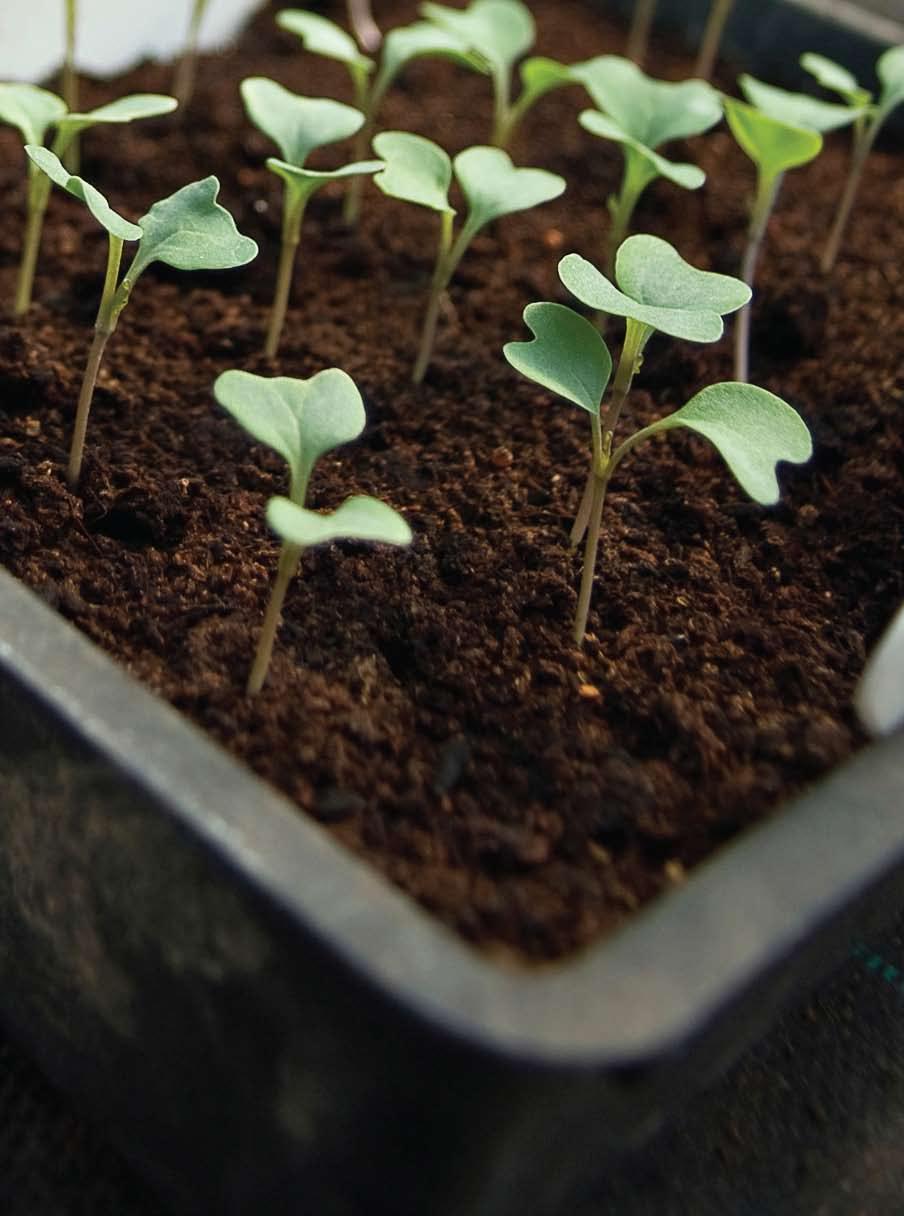
The Green Arts District will combine Oberlin’s world renowned expertise in the arts and the field of sustainability. By encouraging creativity, innovation, and exploration of the arts and sciences, the Green Arts District will inspire generations of leaders. This cutting edge sustainable development will become a national model for regenerative communities. We need your help to grow this seed.
Contact: Jane Mathison, Assistant to the President, jmathison@oberlincollege.edu
Growing a Sustainable Future Our Vision The Five Principles Why Oberlin? The Context The Green Arts District Site Plan Key Components of the Green Arts District Site Circulation Sustainable Strategies How it Works Clinton Climate Initiative The Potential Phasing Join Us 2 5 6 9 10 12 14 18 20 21 24 26 28 30 32 the Green Arts District
growing a sustainable future
The Seed for a Sustainable Future
Growing a sustainable future will require a multidisciplinary effort combining the arts and sciences. Oberlin College is uniquely positioned to launch a project that joins the many strands of sustainability including urban revitalization, green development, the arts, advanced energy technology, sustainable agriculture and forestry, green jobs, and education into an integrated response. By harnessing the power of human expression and scientific innovation, the Green Arts District will communicate the need to live more sustainably and plant the seeds for a green tomorrow.
Facilities
New facilities in the Green Arts District will accommodate the longstanding needs of Oberlin College to update its venues and will position Oberlin to become a national destination for the arts and a leader in the quest to create vibrant post-carbon communities. In addition, the emphasis on environmental design will connect students and faculty to the natural world. This relationship will be incorporated into life and learning at Oberlin while providing the context for advancement in the arts and sciences. To accomplish this ambitious goal, Oberlin is targeting a city block in the heart of the campus to become a beacon for the vibrant post-carbon community of the future. The selected block neighbors historic Tappan Square and currently houses a few of Oberlin’s most recognized landmarks: the Allen Memorial Art Museum and Hall Auditorium. Select infill development on this block will compliment those uses while creating many new needed facilities including the Oberlin Inn, classroom and performance space, student housing, and the new Center.
Leadership
Oberlin is widely known for its historic leadership in progressive causes. In 1835 Oberlin became America’s first college to adopt a policy to admit students regardless of race, and two years later the first coeducational institution. In the twentieth century, it similarly led on a variety of human rights issues and emerged as one of America’s most distinctive and distinguished liberal arts colleges. In the late 1990s, Oberlin again showcased its leadership by constructing the first substantially green, entirely solar powered, zero-discharge building on a U.S. college campus (the Adam Joseph Lewis Center). In 2004, the Trustees adopted what is still the most comprehensive environmental policy in higher education. In 2006, the college became a charter signatory to the American College and University Presidents’ Climate Commitment. Oberlin now seeks to launch the most ambitious green development and education project yet proposed by any comparable institution of higher education.
Impact and Replicability
The creation of transferable lessons, technologies and policies from the Green Arts District will have significant impacts on communities throughout the region. Oberlin is uniquely positioned to pioneer many advances that will be replicable and exportable. The following areas could provide valuable lessons for neighboring communities:
• Green job training
• Expression of ideas of sustainability
• Energy conservation and renewable generation
• College curriculum that integrates lessons from the natural world
• Locally generated economic development
• Entrepreneurial opportunities in the growing green economic sector
• Reach of the arts
SCIenCe + ART
“An extrAorDinAry project thAt will trAnsform A community AnD show AmericA how to creAte A prosperous, creAtive AnD sustAinAble worlD… visionAry, revolutionAry, AnD certAinly necessAry”
Sherrod
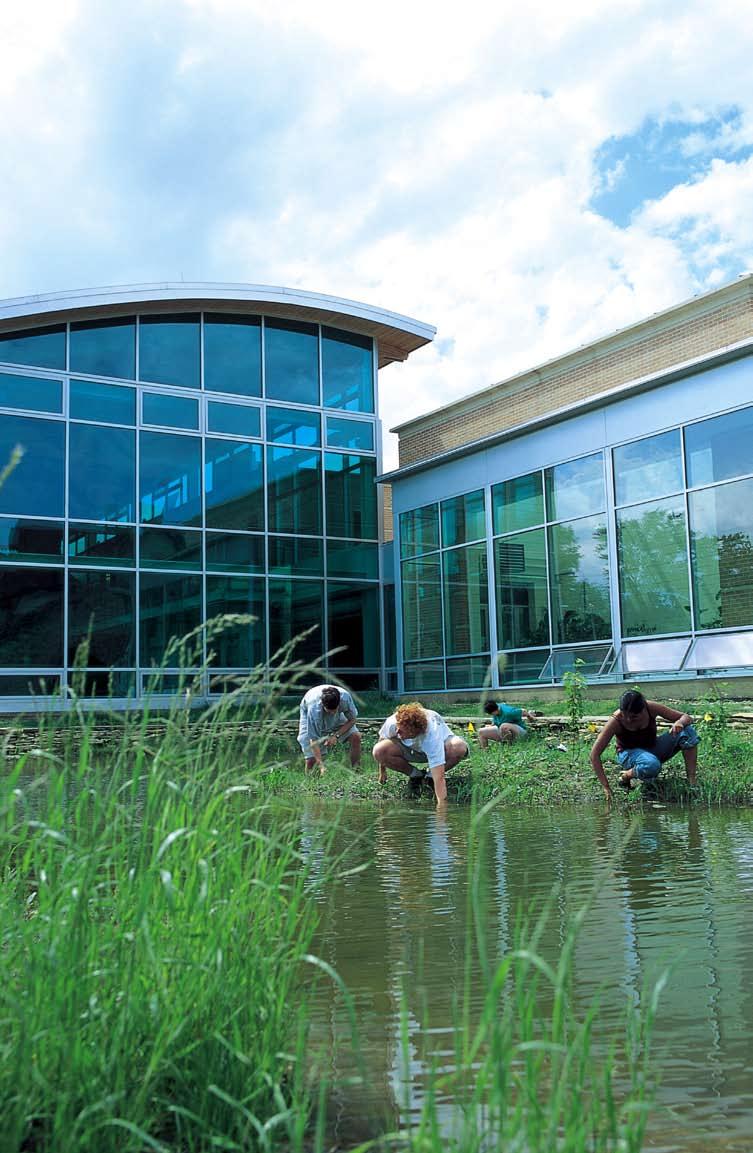
Senate
The Green Arts District 3
Brown, U.S.
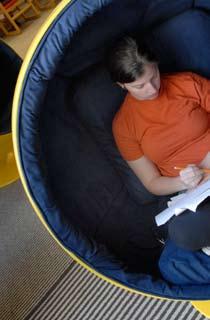





the green arts district will be a laboratory for exploring possibilities, promoting innovation in arts, music, sciences and sustainable design to reweave community, transform the way we learn and create new post-carbon economies.
OuR vISIOn
The Green Arts District 5
1: postcarbon economy
Embracing the challenges and great possibilities of the next century, we acknowledge the monumental task of transforming our local and global economy. The Green Arts District will provide an example of how, by living smartly, it is possible to improve the quality of our lives and heal our planet.
2: community
As a town and college we embrace the great opportunity and responsibility to renew our communal aspirations and strengthen our joint commitment to local and global communities.
The FIve PRInCIPLeS
3: learning
Through transformative interactions among the arts, sciences, and the natural world we will initiate new ways of thinking, teaching, and learning.
4: sustainability
Leading through study and practice, we will embody sustainability through our actions, creating models that exhibit integrated solutions, amplifying environmental health, prosperity, and humanity.
5: exploration
Creativity, experimentation, and collaboration are ingredients for innovation and understanding. The Green Arts District will demand exploration and reveal the human spirit.
The Green Arts District 7

“oberlin colleGe AnD the city of oberlin hAve lonG shown reAl leADership in DrivinG innovAtion…this project hAs the potentiAl to Drive reAl chAnGe in the wAy our communities Are plAnneD, DesiGneD, AnD built – AnD, ultimAtely, the wAy we expect our communities to sustAin the heAlth of our environment, our economy, AnD our populAtions.”
Rick Fedrizzi, President, CEO and Founding Chair, U.S. Green Building Council

why oberlin?
In the heart of the rust belt, Oberlin College and the Green Arts District is ideally positioned to shape the national dialogue surrounding education, sustainability, and the future of a green economy. By simultaneously advancing its teaching and providing a replicable model to the region of how a postcarbon economy can function, the work of the College has never been more relevant or more needed. Blending the strengths of its nationally recognized arts and ecological science programs the College has the opportunity to provide solutions to the challenges of the 21st century.
The Green Arts District 9
the context

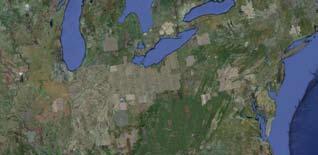
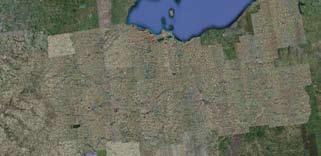

eARTh RuST BeLT
OBeRLIn
MAIN
PLEASANT
LORAIN
PROFESSOR
Green Arts District 11
COLLEGE WALNUT the green arts district
The
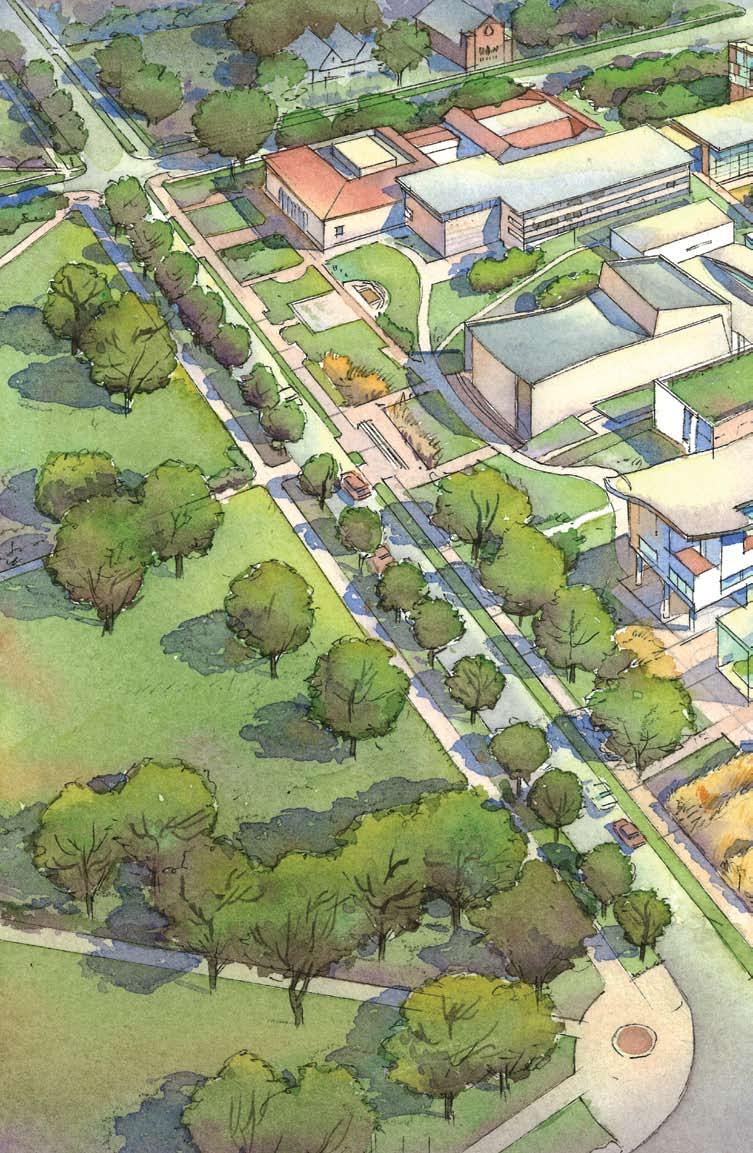

the Green Arts District
site plan
The relationship of the Green Arts District to its surroundings is an important part of the overall design. The proximity to downtown and Tappan Square provide opportunities to build connections and strengthen the fabric of the built environment. The building frontages reinforce these connections. Based around the existing quad system on campus, the Green Arts District complements the existing campus patterns.
A TAPPAn SquARe
B ALLen MeMORIAL ART MuSeuM This landmark, 1917 art museum is currently being renovated with a goal of a LEED Gold standard. The renovation includes geothermal wells to optimize energy performance, water-efficient landscaping, water-use reduction, and use of recycled and regional materials. New construction will allow the Allen Memorial Art Museum to expand into the Clarence Ward Wing providing additional exhibition space and program development to more effectively serve the College and Community.
C venTuRI ART BuILDInG RenOvATIOn AnD exPAnSIOn [30,000 sf]
The existing Venturi Art Building will be renovated and expanded to provide flexible, collaborative studio spaces for the arts.
D WORkShOP [7,500 sf] The workshop will provide space for the performing and visual arts including set building, sculpture, and other studio art activities. Large doors will connect the space to the adjacent gardens. Additionally, the workshop would be used as laboratory space for innovative sustainability concepts allowing collaboration of College students, faculty, and potentially local entrepreneurs, inventors and regional students.
E hALL AuDITORIuM The historic structure will be renovated to provide space for opera and other performance based arts.
F STuDenT hOuSInG [240 units] The Green Arts District will provide 240 new housing units. Live/Work space will be incorporated into the housing facilities, providing studio space for student artists. The student residences will offer superior environmental performance, boosting productivity and health while providing instant feedback on the impact of occupants’ energy consumption. These spaces would act as transformational living units, providing students an understanding of a lifestyle that is respectful of available resources.
G The CenTeR [20,000 sf] The Center will become a national hub for engaging and resolving challenges facing sustainable design and successful post-carbon communities. See page 18 for more detail.
H GReen TheATeR [7,000 sf] The Green Theater consists of 200–250 seats around a semi-thrust stage. The theater will be available for a full season of curricular projects, theater, opera, dance, and music. This highly flexible facility will create a national model illustrating the blend between performance and sustainability.
I CuRRICuLAR ARTS BuILDInG (epicenter for Sustainable Creativity) [72,000 sf] – This state-of-the-art facility will house the Art Library, Media Lab, impromptu rehearsal space and green classrooms. See page 18 for more detail.
J eCO-MAChIne A natural systems based waste-water treatment facility showcasing the beauty and potential of this exciting technology. See page 18 for more detail.
K FORuM [35,000 sf] The forum functions as an open space for the cross-pollination of ideas. Uniting the programmatic elements of the district, the Forum will bring students, faculty, visitors and community members into a common space organized around shared interests.
L LeCTuRe hALL This signature lecture hall will exemplify characteristics of high-performance design. Connecting the curricular building to the Inn and conference center, the space could also accommodate conference use.
M ReSTAuRAnT (First Floor) This-state-of-the-art facility will incorporate locally grown food into the menu to enhance the connection to the local economy and environment. The partnering of a Culinary Arts Institute with the restaurant could provide training for local students and community members in the art of cooking with locally grown produce.
N OBeRLIn Inn [75,000 sf] With the creation of the Green Arts District, the Inn at Oberlin will be reborn as a leading example of the College’s commitment to sustainability. Using locally sourced materials and thoughtful, provocative design, the Inn will become a valuable amenity with the ability to house worldclass conferences.
O APOLLO TheATeR The sustainability of downtown of the City of Oberlin has been enhanced by the recent purchase and updating of the Apollo Theater by the College. Upon completion of the proposed renovation, with a goal of LEED silver, College faculty will teach cinematography to College as well as community students.
P BLACk BOx [3,000 sf] The Black Box is an adaptable space for cross-curricular studio and performance with flexible seating for 100–150. We recognize the need for a multi-functional venue to showcase the diverse talents of our students and faculty as well as community members.
New Construction Renovation
Existing
A B C D E F G H I J K L M N O P APOLLO THEATER W COLLEGE STREET MAIN STREET K F F DOWNTOWN
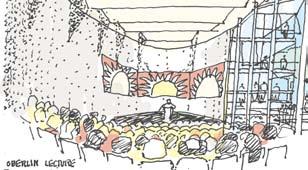


 left to right, top to bottom: Lecture Hall, Green Box Theatre, Art Studio
left to right, top to bottom: Lecture Hall, Green Box Theatre, Art Studio
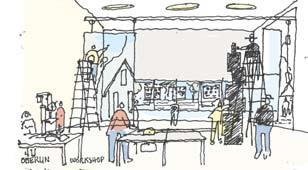



The Green Arts District 17
left to right, top to bottom: Workshop, Lobby, Cafeteria
key components of the green arts district
The CenTeR
The Center will become a focal point of the national discourse around the future of the planet. This extraordinary educational facility will advance the practice of ecological design. The building itself will demonstrate state-of-the-art building technologies; it will generate more energy than it uses, clean the air, purify its own waste, and contribute to the health of the planet. Bringing together experts from around the globe to address specific design challenges and solve real problems, the Center will advance green design, city planning, environmental studies and post-carbon economic development and policy.
The eCO-MAChIne
Recognizing that conventional waste-water systems carry a much larger carbon footprint, due to greater energy consumption, and that they fail to harvest the latent nutrients found in wastewater, the Green Arts District will install an Eco-Machine, which will use substantially less energy while converting the traditionally discarded waste-water nutrients into assets for the community and environment.
The Eco-Machine figures prominently in the Green Arts District by utilizing biological systems including wetlands, plantings, and other organisms. The system, based on ecological design principals, will transform the district’s wastewater into pure, pristine water.
In the near future both phosphorus and clean water will become increasingly rare commodities. The Eco-Machine will work symbiotically with the other ecologies of the Green Art District to move away from the conventional linear food, energy and hydraulic cycles to create regenerative local systems. The facility itself will serve as a poignant educational tool and living art display in keeping with the philosophy for the Green Arts District. The Eco-Machine is truly a system for the future and an emblematic icon of the Green Arts District.
CuRRICuLAR ARTS BuILDInG
Much of the development in the Green Arts District will significantly advance the teaching and understanding of the arts. By fundamentally integrating natural systems into the built environment, the Green Arts District will provide an inspirational space for artistic creation while improving environmental performance.
The Curricular Arts building will house a diverse set of uses. Classrooms, administrative offices, rehearsal spaces, the Arts Library, and a possible college and community radio station are envisioned as occupants in this highly collaborative space. The building’s design reflects an understanding of the arts as a process, not merely a product. The building will reveal the process of creativity to the outside world by maximizing transparency and encouraging participation. This increased access to light and air will improve human health and productivity.


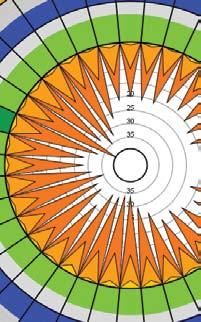

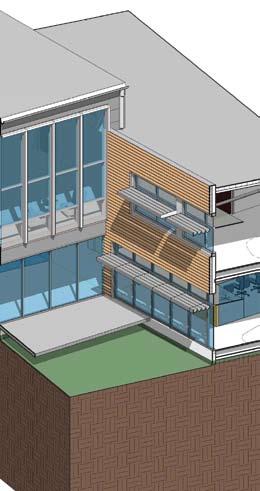
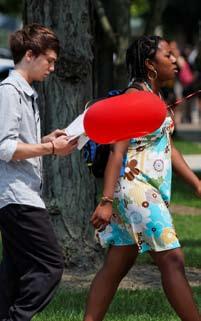
The Green Arts District 19
site circulation
The site circulation is designed to both restore the historic promenade fronting on Tappan Square while also allowing maximum permeability into the District. A series of formal and organic connections within the site allow students, faculty, and visitors to mix where appropriate while also creating private spaces for College users. The ability of the district to act as a learning laboratory also encourages exploration of the buildings and the landscape to capture imagination and boost learning.
1 3 4 5 1 Campus Promenade 2 Forum Circulation 3 Interior Site Circulation 4 Live/Work Circulation 5 Loading Access 6 Emergency Access PEDESTRIAN CIRCULATION VEHICULAR CIRCULATION 2 5 6
sustainable strategies
The Green Arts district will utilize cutting edge active and passive building technologies and site design strategies to incorporate natural systems into the built environment. By acknowledging the natural conditions, including hydrology and solar orientation, the Green Arts District maximizes natural day-lighting and achieves zero storm-water runoff. The eco-machine treats all the waste generated by the school and living buildings, and the landscape of the district works to harmoniously augment comfort and productivity. The minimization of energy use through building design, form and orientation will be coupled with energy production strategies such as photovoltaic panels, geothermal, biogas from site based waste, use of landfill gas or biomass for central heating and energy production, and the potential installation of a wind turbine for education purposes.
Eco-Machine Landscape
Greenroof Research Zones
Promenade Landscape
Productive Landscape
Live/Work Gardens
Eco-machineTM 7 Waterflow 6 6 6 6
1
2
3
4
5
6
LANDSCAPE ZONES
1 1 2 3 4 5 6 7 The Green Arts District 21
WATER ZONES


 left to right, top to bottom: Green Roof, Green Dorm, Art Quad
left to right, top to bottom: Green Roof, Green Dorm, Art Quad


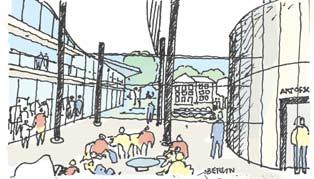

The Green Arts District 23
left to right, top to bottom: Green Housing, Lobby, Eco-machine
how it works
By combining cutting edge green building technologies and people centered design with the site ecology, the Green Arts District will create an inspirational learning environment that promotes collaboration and innovation and reveals our connection to nature. A few of the natural and cultural elements of the district are highlighted here.
Natural Systems
The natural world provides sustenance for life, nurturing diversity and favoring robust interdependence. Lessons for prosperity, health, and cooperation are inherent in the natural world. The Green Arts District represents an opportunity to take a holistic view at these lessons and the connections between natural and cultural systems are the focus of the design. Each system will be optimally synchronized to make the district work better as a whole. The GAD will be designed in a holistic manner to reflect our ecosystem, allowing for the optimization of individual buildings in the context of the whole.
WATeR Water scarcity has begun to join global warming as one of the major threats to sustainability in this century. Tied to the Black River watershed and Lake Erie, the Green Arts District will celebrate water as a precious resource by making it a visible part of the design. Recycling of wastewater, rainwater harvesting, efficient fixtures and water elements will feature prominently in the aesthetics of the project while simultaneously improving water quality and eliminating runoff.
e ne RG y In both efficiency and generation the Green Arts District represents an opportunity to demonstrate the economic and environmental benefits of a host of regenerative design techniques. These techniques include: green roofs, photovoltaic panels, wind energy, geothermal energy, building envelope optimization, LED lighting, light shelves, and many other emerging technologies.
SunLIGhT Sunlight powers the natural economy. Solar energy can be used to improve human health, minimize energy demands, and increase productivity. The site and building design for the Green Arts District will maximize access to natural light. This access will be controlled with shading devices to minimize heating and cooling loads as well as allow for room darkening.
FOOD Our current industrial food system has become overly complex and fragile. It is propped up by unsustainable practices and unwise subsidies. Through the practice of permaculture the Green Arts District will create a more sustainable food system comprised of on-site and local food production that is integrated with a regional food network. The local food network reveals the connections between our food and the environment and increases food security in an era of rising energy costs and climate instability.
M AT e RIALS Locally available materials will be used to construct the Green Arts District, both lowering the footprint of the construction process and stimulating the local economy. Everything from raw materials to finished products will be thought of as an opportunity to develop local sustainable material sources, craftsmanship, and ingenuity.
Cultural Systems
Diverse cultural ties provide support and engender innovation by allowing us all to act together to improve our quality of life.
COLLABORATIOn The strength of the Green Arts District comes from finding new collaborations between arts, sciences and sustainability. Functionally and programmatically the Green Arts District will create new connections and relationships between diverse disciplines and knowledge bases.
eCOnOMy Creating a sustainable economy in a post-industrial, postcarbon world requires a dramatically new way of thinking. We must focus on generating creativity, knowledge and talent. As the economic climate continues to evolve, we must adapt by building networks and renewable systems that connect to the local as well as global economies. The Green Arts District is pion eering new economic models; it is a sustainable development primed to succeed in the post-carbon world, and it is creating the skills needed to ensure a vibrant future economy.
COMMunICATIOn The arts enable diverse modes of human expression. Emphasis on increasing multiple types of literacy through the arts is central to the success of the Green Arts District. By communicating what it means to be human, the arts reveal our intractable relationship with nature and the imperative to live more sustainably.
COMMunITy Community is the web of relationships that connect people to place. Strong communities are resilient and can mobilize in the face of changing circumstances. The Green Arts District wi ll strengthen community by establishing institutions that bring together students, faculty, and residents. In a time of growing awareness about the performance of our cities – socially, environmentally and fiscally — we believe strengthening community is an important step toward ensuring Oberlin’s vitality.
ReSILIenCe Cities are the result of a series of built and natural systems that are interconnected and interdependent. As we envision a new future for our cities, we must also consider the changes they must endure as climate change affects our ecology and economy. We intend for the Green Arts District to be highly adaptable and resilient.
TIMe Fractured and hurried, the modern lifestyle risks the loss of contemplative decision making. Deep thought requires time and meditation. One of the intentions of the Green Arts District is to create a place where perspective and rationality can healthfully mix with creativity.
WASTe In the natural world waste = food. The Green Arts District will use that lesson to minimize or eliminate construction and operational waste. Finding the use for current waste streams is both a business opportunity and a moral imperative.
clinton climate initiative
the Green Arts District
The Oberlin community—college and city—has been selected to join the Climate Positive Development Program, a joint initiative of the Clinton Climate Initiative and the U.S. Green Building Council. Launched in May 2009, the Climate Positive Development Program (CPDP) supports the development of large-scale urban projects demonstrating that cities can grow in ways that are climate positive—able to reduce the amount of on-site CO2 emissions to below zero. This recognition places Oberlin alongside 17 other global development projects from Seoul, London, Sydney, and other major metropolitan destinations. Selected for its commitment to leadership, the CPDP recognizes the capacity of the Green Arts District to implement economically viable innovations towards climate positive goals for buildings, energy, transportation, waste, water, materials, and sequestration. Through the Climate Positive program the Green Arts District will be integrated into an elite global cooperative and will become the only project recognized that demonstrates retrofitting sustainable developments into existing city fabric.
The Green Arts District 27
the potential
The Green Arts District will improve the community of Oberlin, bring economic opportunity back to the rust belt, become a model for a prosperous and sustainable climate positive economy, and impact the global conversation on sustainability. The investment will catalyze redevelopment of the existing downtown, develop new green jobs and spur innovation while establishing Oberlin’s leadership role in the 21st century.

“thrillinG, bolD, imAGinAtive, AnD compellinG…potentiAlly An internAtionAl moDel”
Judith Rodin, President, Rockefeller Foundations

The Green Arts District 29
phasing
Oberlin College is already moving ahead with renovations to the Allen Memorial Art Museum bringing it up to the LEED Gold standard. Moving forward, the Green Arts District will be developed in three phases over the next ten years:
• In PhASe 1, a four-star hotel, restaurant and conference center, ecomachine, curricular arts building, the connecting forum structure, a new lecture hall, and a black box theater will be built in the southern portion of the block.
• In PhASe 2, we propose the design and construction of 240 additional student housing and collegiate live/work spaces. The green theater would also be built at this time. Improvements to Tappan Square could also move forward in this phase.
• In PhASe 3, new construction will begin on the Art Building expansion, substantial improvements will be made to the Allen Memorial Art Museum and Hall Auditorium, and the new workshop space will be built. This phase also includes the center and the installation of energy generating technologies that will serve the entire block.
PHASING KEy
Design Construction
$73.5M
Estimated Cost
Design Construction
$78M
Estimated Cost Design Construction Estimated Cost
$80M
10 years
PhASe
PhASe
0 5
PhASe 1
3
2
The Green Arts District 31
it begins with a seed
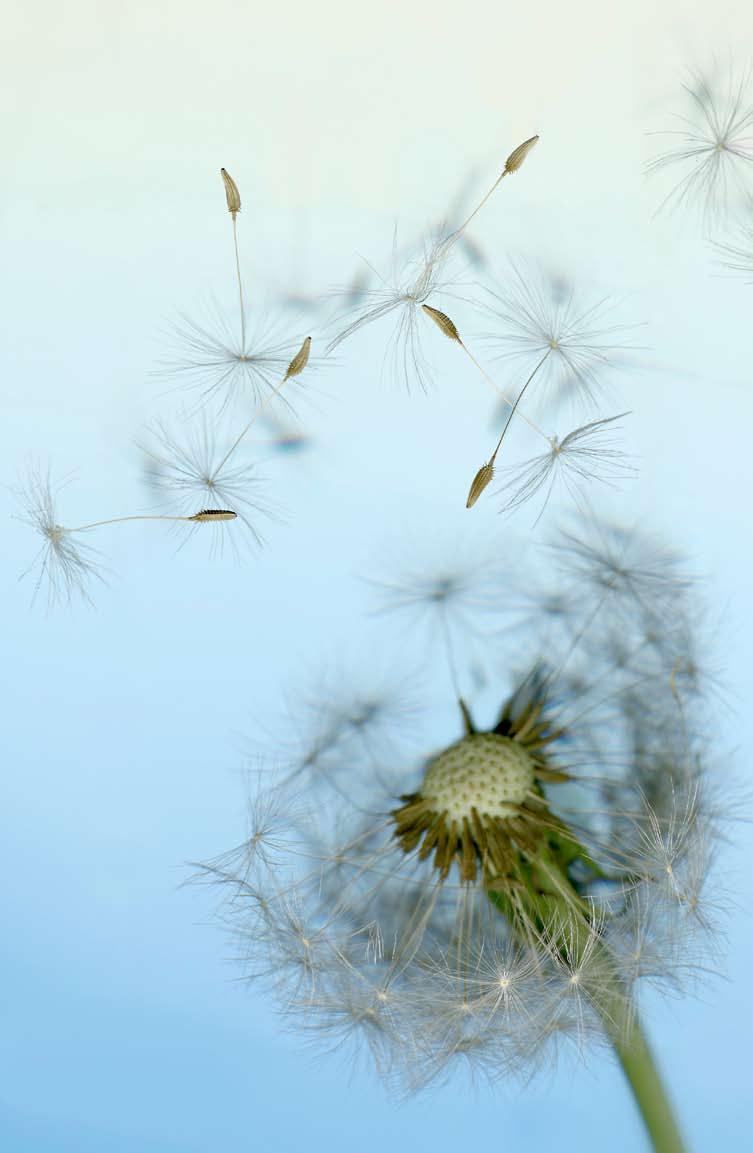
begins seed

The leadership and vision of Oberlin University together with the support of the City of Oberlin creates an incredible opportunity to bring this idea to fruition. Oberlin is long overdue for a facility to match the incredible artistic talent and innovative capacity of its students and faculty.
The world is facing economic and ecological crises that demand new ways of thinking. The Green Arts District provides a new model of sustainable development designed to meet these challenges. Oberlin’s dedication to innovative multidisciplinary education will inspire generations of world changing leaders.
The Green Arts District plants the seed for a post-carbon world.
help the Green Arts District take flight. your commitment of time, resources and ideas will establish an immeasurable legacy.
The Green Arts District 33
BOOk DeSIGn & ILLuSTRATIOnS
BNIM
Copyright 2010.
All rights reserved. No part of this book may be reproduced, stored in a retrieval system, or transmitted in any form or by any means, including electronic, mechanical, photocopying of microfilming, recording, or otherwise (except that copying permitted by Sections 107 and 108 of the U.S. Copyright Law and except by reviewers for the public press) without written permission from the all Teams / Partners of this book.
The Green Arts District




















 left to right, top to bottom: Lecture Hall, Green Box Theatre, Art Studio
left to right, top to bottom: Lecture Hall, Green Box Theatre, Art Studio












 left to right, top to bottom: Green Roof, Green Dorm, Art Quad
left to right, top to bottom: Green Roof, Green Dorm, Art Quad







